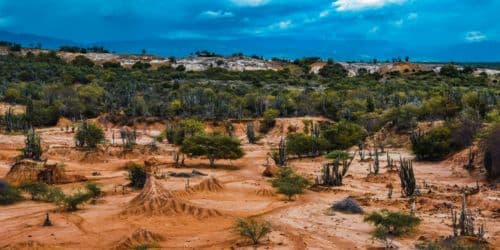Nigeria boasts some of the most attractive tourist attractions and historical sites with cultural, historical, scientific, or other types of significance, whether for education, amusement, leisure, or pleasure. Here, we’ll walk you through some of the historical sites in Nigeria, and what they represent.
Historical Sites In Nigeria
#1. Oduduwa Grove
Oduduwa World Temple, also known as Oduduwa Grove, is located in Ile-Ife, Osun State. The location is significant because it is where Oduduwa, the legendary progenitor of the Yoruba race, landed with a chain. He established Ile Ife, which later became his final resting place. A statue of Oduduwa with the chain and staff can be found here.
#2. Nigeria’s First-Storey Building
Badagry, Lagos, is home to Nigeria’s first-storey building. The house’s foundation was established in 1842, and it was finished in 1845. Reverend Henry Townsend of the Church Missionary Society (CMS) built this antique edifice.
#3. National War Museum
The National War Museum in Umuahia, Abia State, exists to commemorate the tragic events of wars as well as the process of national reconciliation and healing. This museum displays remnants from several wars, notably the Nigerian Civil War and conflicts in the Niger Delta. Weapons used in wars in ancient Nigerian empires are also depicted.
#4. Obudu Mountain Resort
Obudu Mountain Resort, or Heaven on Earth, as it is often known, is located in Obudu, Calabar. The Obudu cattle ranch would leave you dumbfounded and wondering if you are still in Nigeria, as it is said to be one of the few spots in Nigeria where snow falls. The tranquility that one experiences is why the Obudu mountain resort is one of Nigeria’s most popular tourist destinations. It is appropriate for a honeymoon, vacation, leisure, and trekking.
At Obudu Mountain Resort, you may participate in a variety of activities such as sightseeing, hiking, playing outdoor sports, taking a canopy walk (if you enjoy watching birds and feeling close to nature), and riding the cable car to explore the mountain’s beauty.
It is also preferable to come between October and February because the weather is pleasant for hiking during this time. In addition, the Calabar Carnival, which takes place in December, is one of the richest and most anticipated carnivals in Nigeria, as is the Obudu Ranch International Mountain Race, which is renowned as “the world’s richest mountain race” and takes place in late November.
#5. Badagry
Badagry is a prominent Lagos town that is frequently searched for by travelers (both domestic and international) looking for places to visit in Nigeria.
The town is steeped in history and culture. During the Trans-Atlantic slave trade, it was a significant slave port, exporting hundreds of thousands of slaves to South America, particularly Brazil. Though the town had a horrible past, it is now a major tourist attraction with monuments, areas of interest, beaches, resorts, slave trade artifacts, and antiquities. The Black Slavery Museum, Gberefun Island (Point of No Return), and the Velekete slave market are the top attractions in Badagry. The Badagry Festival, which takes place every August, also allows travelers to learn about the rich culture of the Badagry people.
#6. Olumo rock
This rock, located in Abeokuta, Ogun State, is one of Nigeria’s most popular tourist spots. One of the most appealing aspects of Olumo Rock, which sits 137 meters above sea level, is its ease of ascent. Olumo Rock had stairs built into it for easy climbing even before the current restorations. Those who do not prefer to climb through the rocks can reach the summit via staircases or lifts.
The pinnacle of the rock provides a panoramic view of other tourist attractions in Abeokuta, including the First Church of Nigeria, the Central Mosque, the River Ogun, and the late Moshood Abiola’s family home. The month of March is always an excellent time to visit Olumo Rock because it is the dry season in the area around the Rock. If you visit Olumo Rock in March, you will also have the option to participate in the Olumo Festivals.
#7. Yankari Game Reserve
The Yankari Game Reserve, located in Bauchi, Northern Nigeria, is the country’s richest wildlife oasis. Yankari Game Reserve is home to Nigeria’s largest surviving elephant population and one of the largest in West Africa. It is home to large numbers of lions, buffalo, hippopotamuses, and other endangered wildlife. However, seeing the creatures is difficult due to the extensive vegetation in the area.
Another draw for visitors to the Yankari Game Reserve is the Wiki Warm Springs. It is 200m long and 10m wide, and it contains crystal-clear water at 31 degrees Celsius. Baboons and elephants frequently visit the springs to drink. The best time to visit Yankari is during the dry season with warmer temperatures, which is normally between March and April, as this allows you to see a broader variety of species.
#8. Idanre Hills
Idanre Hills is a well-known tourist destination in Nigeria. It is one of Ondo State’s and Nigeria’s most amazing and picturesque vistas. There are 660 steps that climb up into the hills, with five resting areas spaced at least 100 meters apart. Idanre is rich in varied cultures and traditions, as well as rare items, objects, and cultural and historical sites.
#9. Ikogosi Warm Springs
According to legend, a hunter had two wives: a hot-tempered woman and a mild-mannered wife. When the two women fought one day, they both changed into springs of water – the fiery-tempered wife became a spring of hot water, and the mild-mannered wife became a spring of cold water. At least, that’s one of the stories about Ikogosi’s warm springs. Ikogosi’s warm and cold springs flow parallel and meet someplace down to form a confluence, each with its own thermal quality. This is the world’s first incident of its kind.
The warm spring is 70°C at the source and 37°C after meeting a cold spring. The meeting place of the warm and cold springs is a unique tourist attraction. According to tourist specialists, the Ikogosi warm spring is one of eight discoveries around the world.
#10. Gurara Waterfalls
Gurara Waterfalls is a popular tourist destination in Nigeria. The facility, which is in Niger State and close to Abuja, is popular with both tourists and Nigerians who come to swim, picnic, and go bird-watching. The waterfall reaches its highest point between April and November, and its lowest point between January and March. Swimming in the river is most safe during the dry season, which runs from January to March, when the water is clear and calm.
#11. Ogbunike Cave
The Ogbunike Caves are located in Ogbunike, a town in Anambra State’s Oyi Local Government Area. The main room contains ten tunnels that lead in various ways. As is customary, visitors must remove their shoes before entering the caves. And women who are on their monthly cycle are unable to go. There is little doubt that the Ogbunike caverns have significant tourist potential, owing to their history, novelty, and the myriad mysteries that lay within its dark depths.
#12. Zuma Rock
Zuma Rock is a geographical landmark in Abuja. It is located outside of the city core but gets a large number of visitors. Famous as the rock with a human face, there is a significant distance between it and other rocks, which the Zuba people interpret as a sort of respect offered by the other mountains to Zuma Rock for its regal presence in the area.
Tourists can visit Zuma Rock all year because the weather is pleasant and warm. If you want to experience the stunning Zuma Rock fire, which only happens during rain, the best time to visit Zuma Rock is between April and October. This has remained one of the wonders to behold over time.
#13. Erin-Ijesha/Olumirin Waterfalls
Olumirin translates as “another deity.” When the inhabitants of Ife were migrating to Erin-Ijesha in 1140 AD, Akinla, a granddaughter of Oduduwa, discovered the Olumirin waterfall in Erin-Ijesha, Osun state. Akinla was also credited with founding the town of Erin-Ijesha. The Olumirin waterfall is one of Nigeria’s most popular tourist destinations. In 2014, it drew over 50,000 people, making it the most popular tourist attraction. The waterfall is revered by the locals as a spiritual spot and a means of cleaning their souls.
#14. The Ancient Nok Settlement
The Nok Culture, which was centered in Jaba Kaduna State, first appeared in northern Nigeria around 1000 BC and perished under mysterious circumstances around 500 AD. Antiquities from the Ancient Nok Settlement can be found in galleries and museums all over the world. The Terracotta figurine was discovered in the Nok Settlement.
#15. Slave Museum
The Calabar, Cross River State Slave Museum displays local slave markets. It has slave trade supplies such as shackles and chains, as well as a range of currencies used to acquire individuals such as copper bars, brass bells, and flutes. During the Slave Trade, Calabar was an important slave port, and this museum contains numerous historical features.
#16. Osun-Osogbo Sacred Grove
Osun-Osogbo Grove is a sacred woodland on the banks of the Osun River in Osogbo, Osun State. This is Nigeria’s unique tourism attraction, with religious temples, sanctuaries, sculptures, and artworks dedicated to the goddess of fertility, Osun. In 2005, it was designated a UNESCO World Heritage Site.
The Importance of Historical Sites In Nigeria
#1. Historical sites in Nigeria serve as cultural and educational markers for Africans.
Historic sites teach future generations about their ancestors’ lives and civilizations. This helps people to get immersed in cultural heritage through the stories told by these sites. It also contributes to the strengthening of the links of unity. If a community is divided by internal conflicts, a historic place shared by all members of that group serves as a reminder that they are descended from the same ancestors and share the same past. As a result, this reminder makes it feasible to support a reconciliation.
As a result, historic sites also have an educational purpose. Historical sites serve as relics of our past by preserving and educating a variety of customs that harken back to our forefathers. This is the case with Egypt’s pyramid sites, which teach us a lot about the time of the pharaohs.
#2. Historic landmarks as a springboard for the African continent’s economic, political, and geopolitical development
Economically, African historical sites draw a large number of historians and anthropologists who come to conduct research. They are also popular with tourists. The latter generate financial revenue for the jurisdiction that hosts these sites.
Some historic buildings and monuments have political significance. They serve as political history’s remembrance. They admonish nations, statesmen, and politicians to avoid certain mistakes of the past by recalling this political history. This is the case with the “Kigali Genocide Memorial,” which serves to remind Rwandans of the horrors of the 1994 genocide while also warning against political manipulation.
#3. Historic sites have a geopolitical stake: the international impact of Africa’s image and pride.
Many schools teach that Africa was a savage continent that was enslaved and then dominated by colonization. Much of Africa’s great history, however, has been obscured; therefore, the function of historical monuments is to recall it. The Egyptian pyramids demonstrate the intellect of powerful African peoples; the “Dahomey Amazon Monument” in Benin commemorates the existence and accomplishments of African woman warriors, serving as a source of pride for African women today. The sites of Toumbouctou (Mali) demonstrate that Africans were already outstanding architects as early as the 15th century; all of these historical sites give a wonderful image of Africa that commands respect and admiration and are also a source of pride for Africans all over the world.
Which City Is Known As Historical City In Nigeria?
Benin City is the capital of Nigeria’s Edo State. A city well-known for its large historical empire, bronze casting, thriving clothing culture, rubber industry, and oil production.
What Are Historical Features and Sites?
Historical sites and characteristics are culturally and historically significant locations. Historical locations containing signs of human activity. Burial locations, for example, Oduduwa Grove, where the Oduduwa landed via a chain found in Ile-Ife, as well as his last resting place.
What are The Types Of Historical Sites In Nigeria?
Cultural, natural, and mixed sites are the three types of sites. Hundreds of ancient buildings and town sites, notable archaeological sites, and works of monumental sculpture or painting are examples of cultural heritage sites.
What is The Oldest City In Nigeria?
Kano, located in northern Nigeria, is the country’s oldest city. Kano was established about the year 1000 AD. It flourished into a major trans-Saharan commerce center, where caravans would rest while crossing the desert.
Historical Sites In Nigeria: Conclusion
Your next trip should include some of these cultural and historical landmarks that will provide you an insight into the life of our forefathers and the amazing legacy they have left us.
- CREATIVITY: Meaning, Writing, Museum & What You Need Know
- Tourist Centers In Nigeria That’ll Be Worth Your Visit
- BEST PLACES TO STAY IN LONDON: Best Areas In 2023
- 23+ Free Things to Do in NYC in 2023 (Quick Guide)
References






